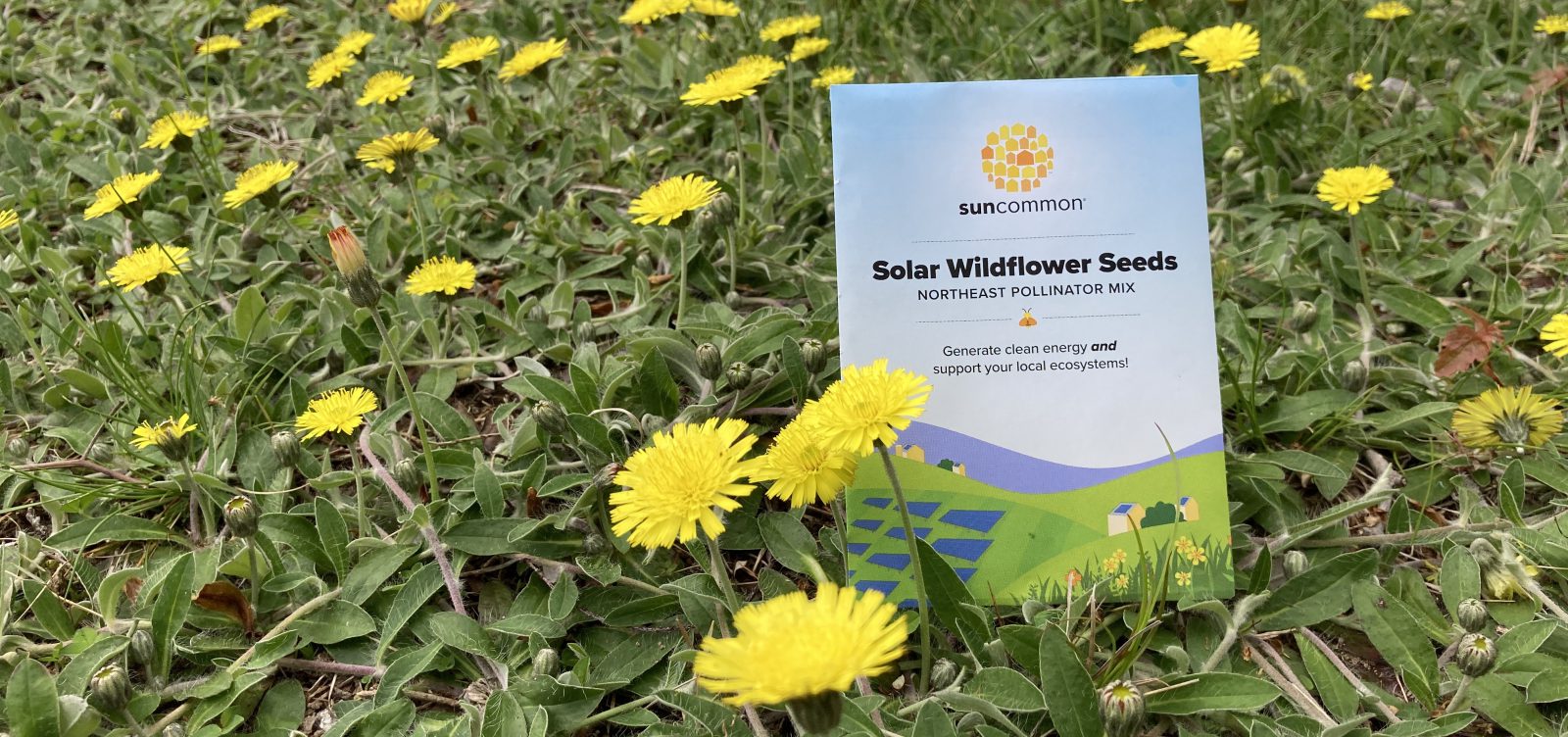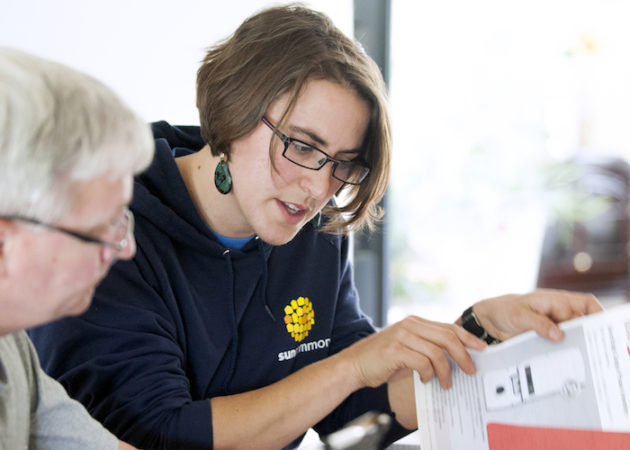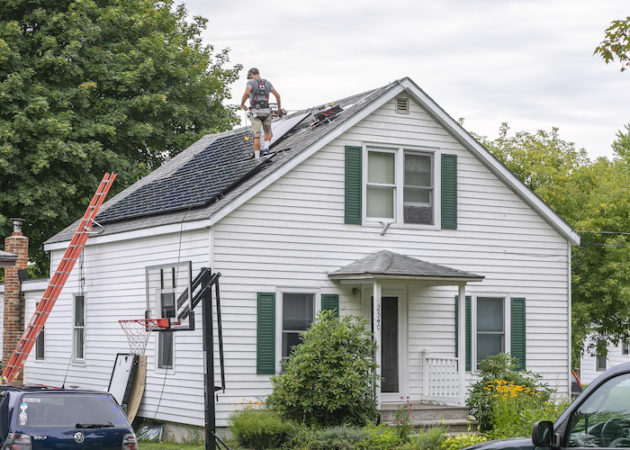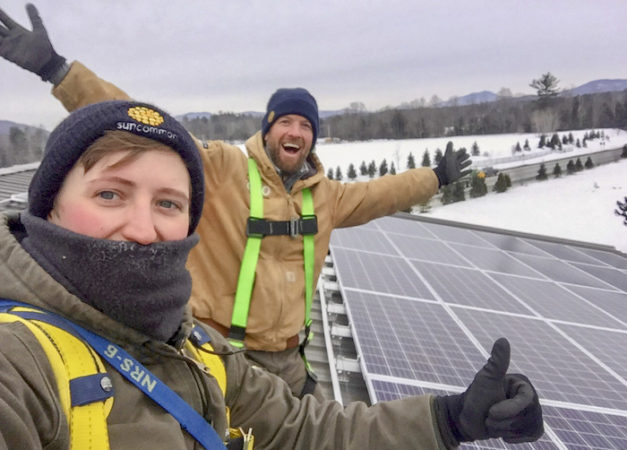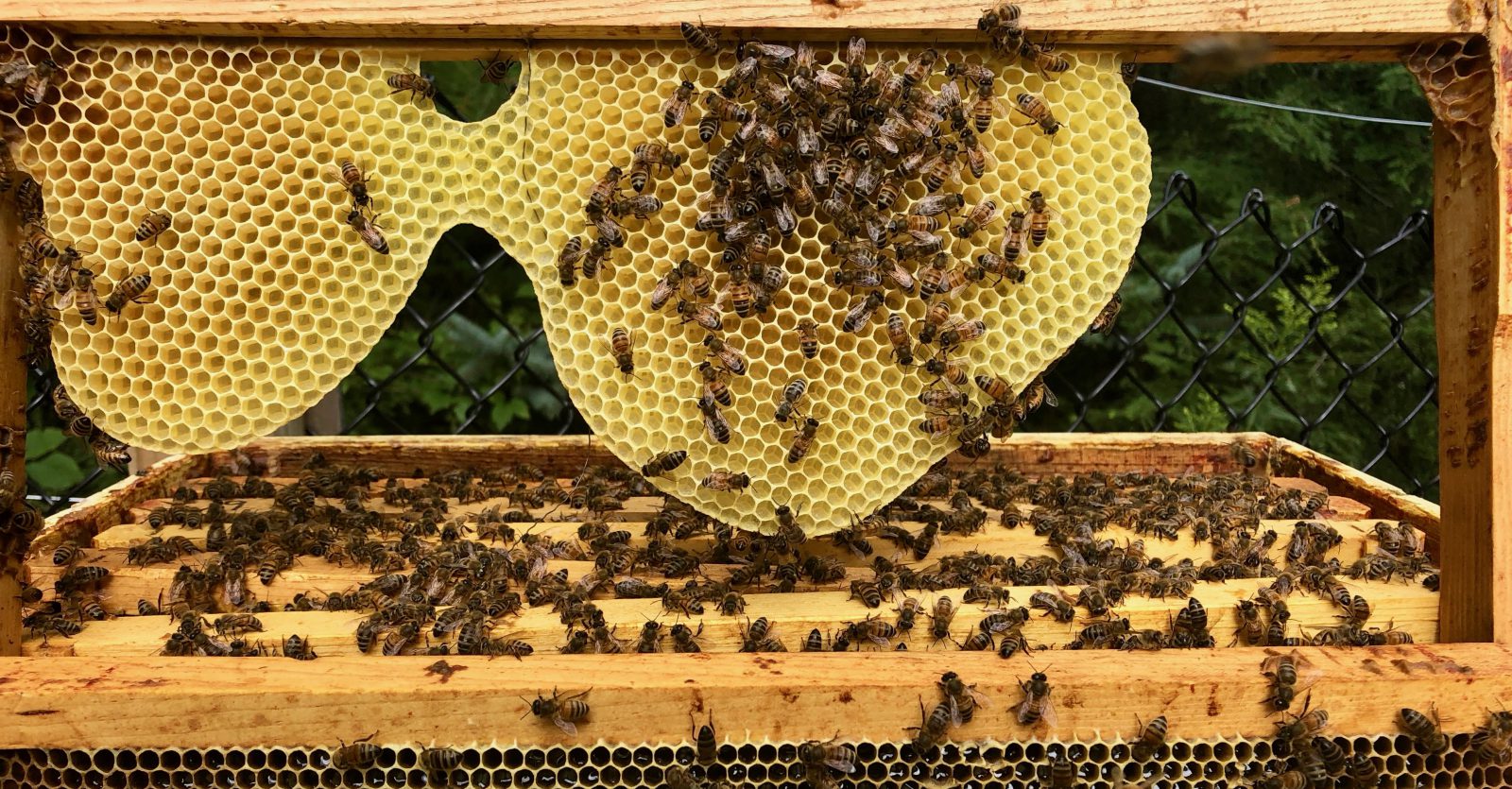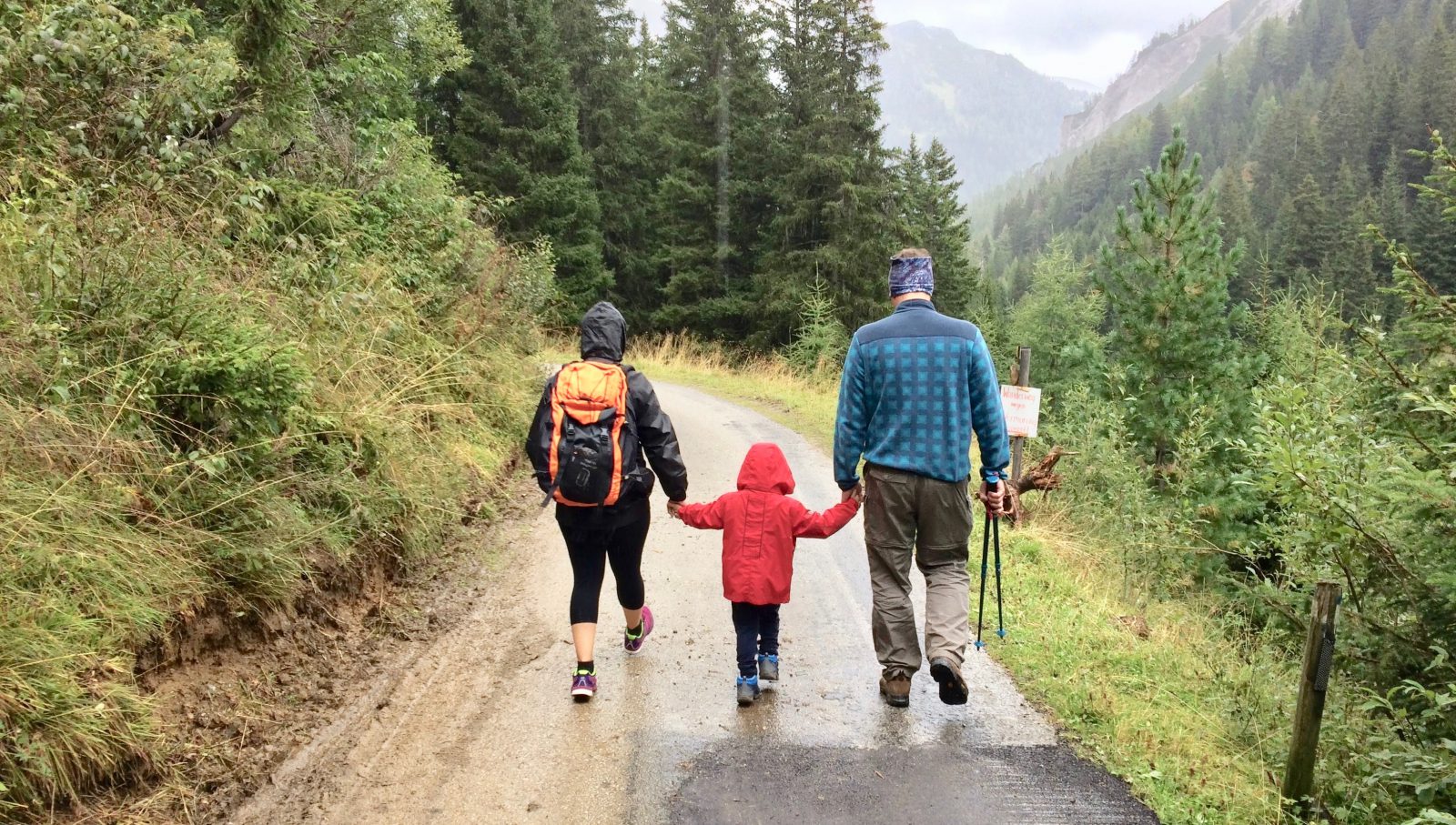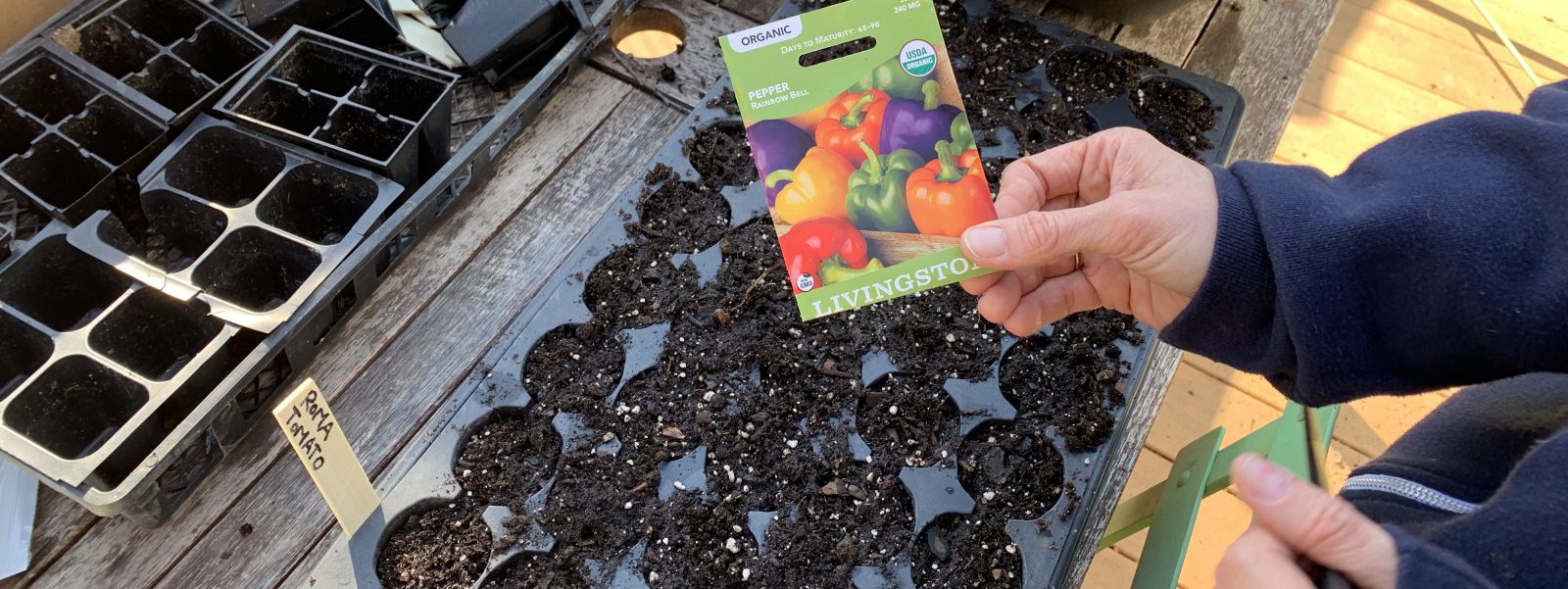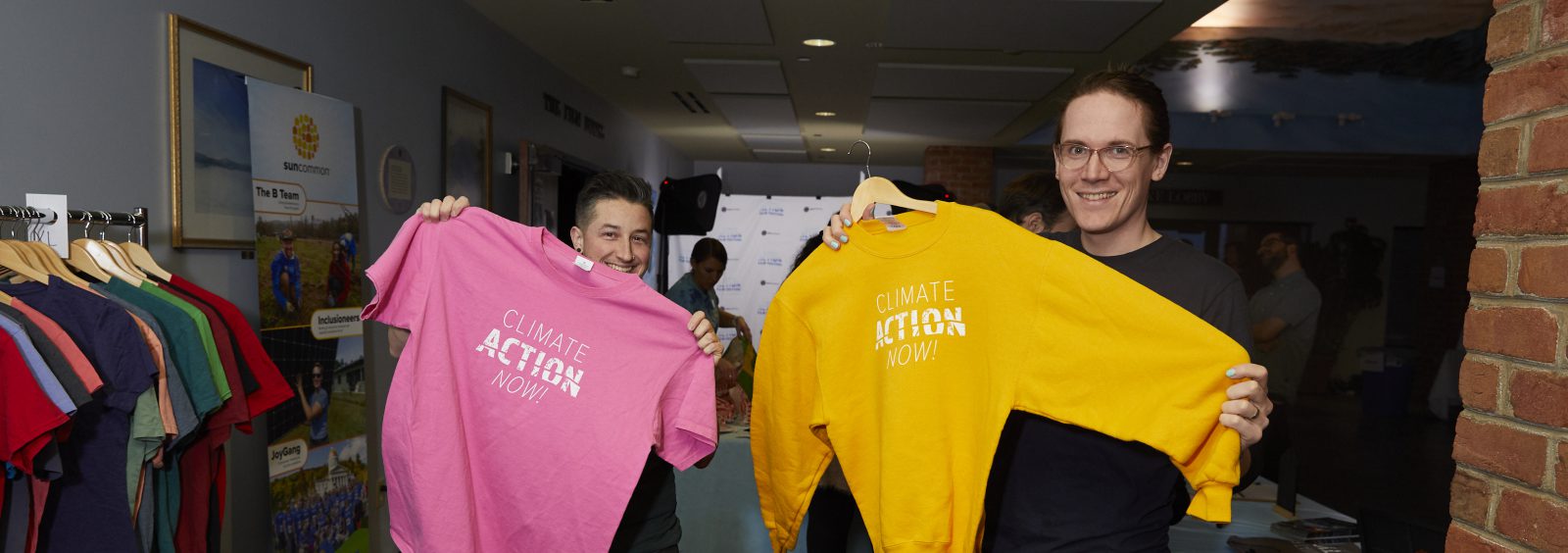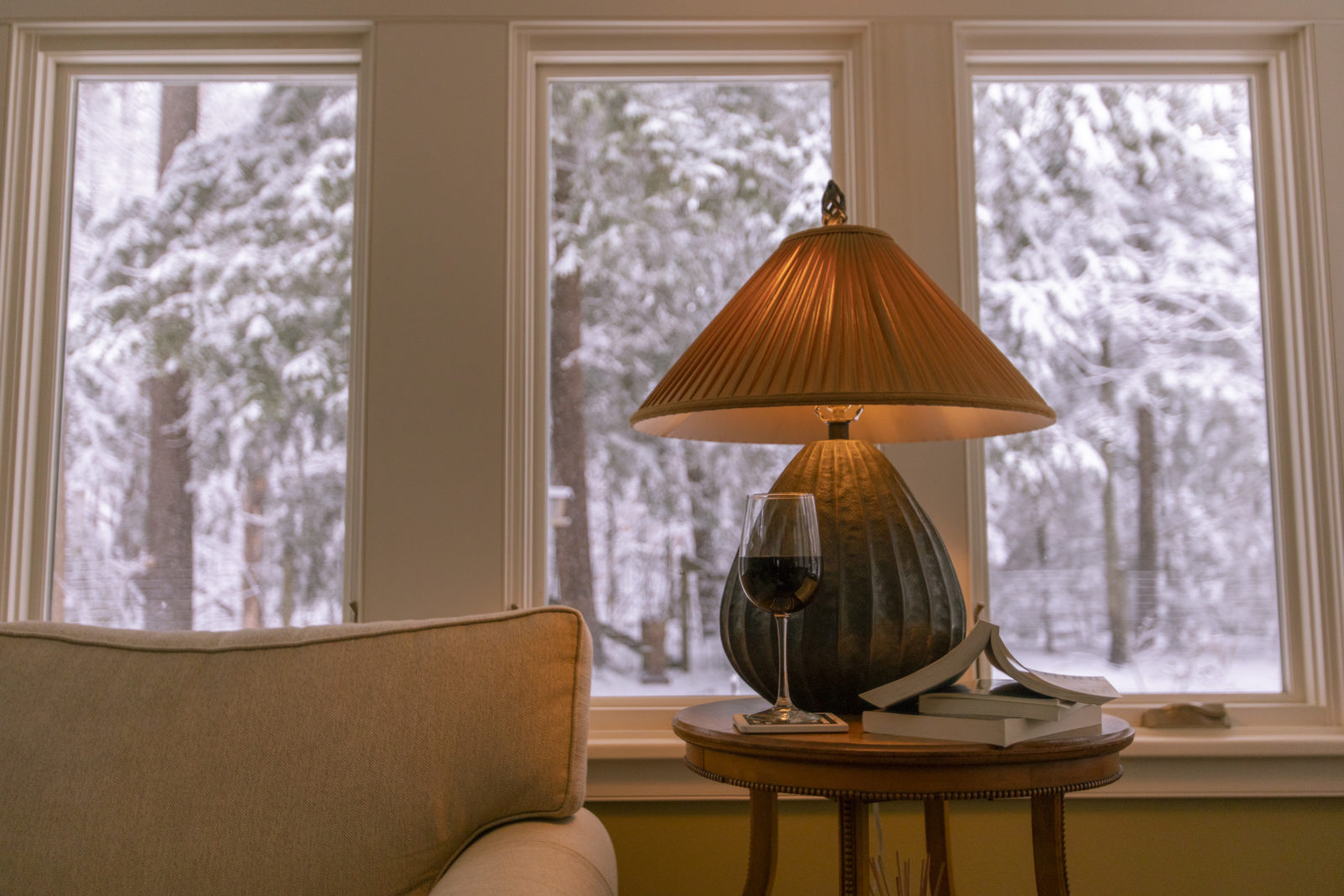The Top Environmental Books to Add to Your Reading List
Whether you spend most of your time indoors, or you’d rather get out and enjoy the sunshine, reading is a wonderful way to pass the time. There’s nothing we appreciate more than cozying up to a good book, especially when the focus is on a cause that’s near and dear to our hearts. We’ve compiled a list of the Top Environmental Books that are worth adding to your summer reading list — We hope you enjoy them as much as we did!
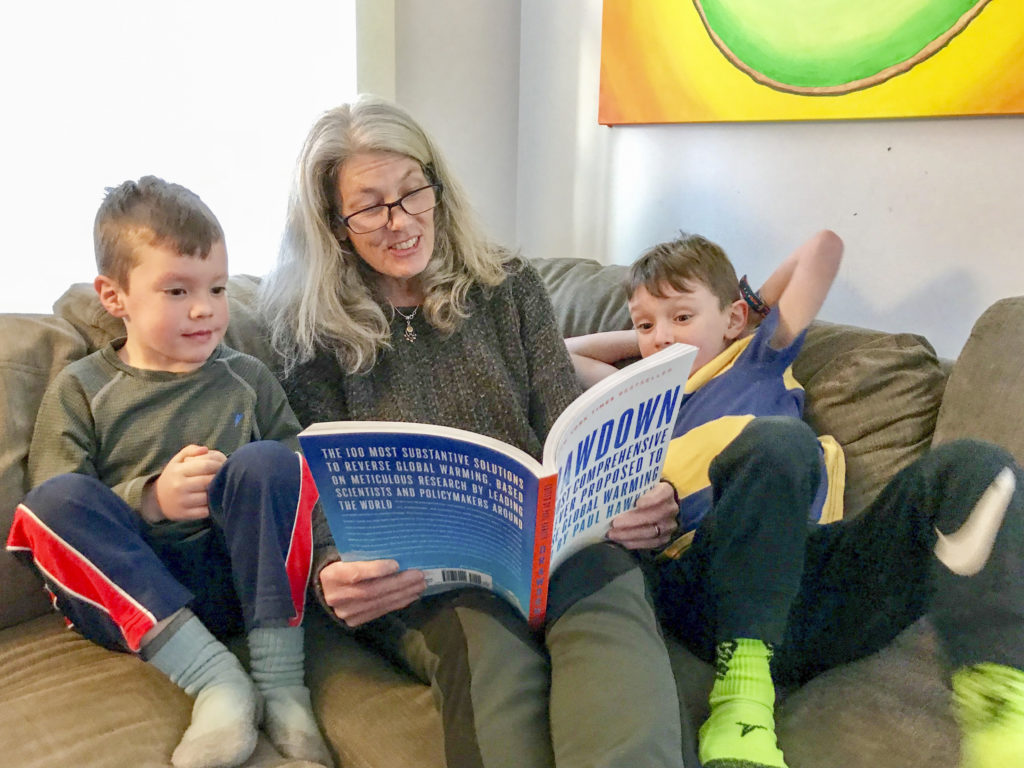

1. Drawdown by Paul Hawken
Obviously, Drawdown had to come up right at the top of our list. If you haven’t checked it out yet, now is the time to crack open this solutions-oriented book. The word “drawdown” refers to the point in time when greenhouse gases will start decreasing year-to-year, instead of increasing like they are right now. This book is “The Most Comprehensive Plan Ever Proposed to Reverse Global Warming”, and discusses the top 100 most effective ways to take positive action for the climate.
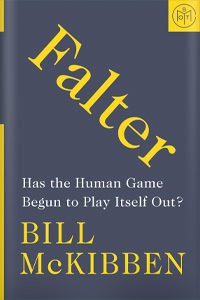

2. Falter by Bill McKibben
This sobering work draws from McKibben’s experience in building 350.org, the first international movement working to end the age of fossil fuels. “Falter” offers ways out of the trap the negative effects of climate change have imposed on us. “In the book’s last section, McKibben offers his reasons for hope. Foremost among these are solar panels, which are making cheap renewable energy available around the world.”


3. The Overstory by Richard Powers
Winner of the 2019 Pulitzer Prize in Fiction, Powers’ latest novel has gotten a slew of rave reviews. We think this praise from Bill McKibben sums up exactly why we added “Overstory” to our Top Environmental Book list: “This book is beyond special. Richard Powers manages to turn trees into vivid and engaging characters, something that indigenous people have done for eons but that modern literature has rarely if ever even attempted. It’s not just a completely absorbing, even overwhelming book; it’s a kind of breakthrough in the ways we think about and understand the world around us, at a moment when that is desperately needed.”
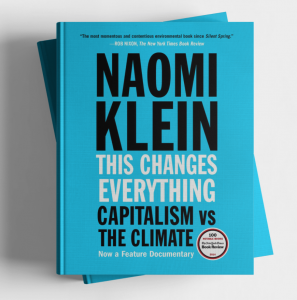

4. This Changes Everything by Naomi Klein
Forget everything you think you know about global warming. This wonderful piece is about transforming our economic system to build something radically better. “It’s about changing the world, before the world changes so drastically that no one is safe. Either we leap – or we sink.” And, if you’re a fan of Naomi, her latest “On Fire“ is another must-read!
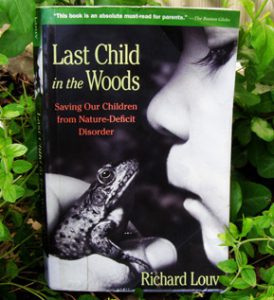

5. Last Child in the Woods by Richard Louv
“Nature-deficit disorder is not a medical condition; it is a description of the human costs of alienation from nature. This alienation damages children and shapes adults, families, and communities. There are solutions, though, and they’re right in our own backyards.” We love the idea of getting back to nature, and bringing your little ones along for the adventure can benefit them greatly! This is definitely worth a read if you want to learn more about keeping your kids connected to all things green.
Did you have coffee this morning? Or maybe you had an after lunch chocolate chip cookie? Well, you have bees to thank for both; they pollinated the coffee beans and the cocoa plant!
Whether you know it or not, pollinators are an essential part of our lives. Without them we wouldn’t be able to produce a lot of the food and goods we count on. Worldwide, there are approximately 1,000 plants grown for food, beverages, fibers, spices, and medicines that need to be pollinated by animals to produce the things we depend on. But, in recent years pollinator populations have been declining. If the trend continues, this could put a strain on our food supply. Climate change, pesticide use, habitat loss and disease are to blame.
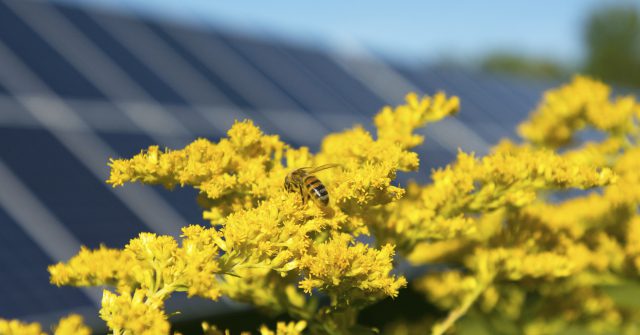

But there’s good news! We can easily support our precious pollinators in our own backyard. That’s why we decided to work with American Meadows to produce a Solar Wildflower Seed mix that provides food and shelter for hundreds of important Northeast pollinators species. (We’ve even used these seeds at our Community Solar Array sites!)
This easy-to-grow blend contains 19 wildflowers, carefully selected to bloom from spring through to the first frost. There are 8 annuals for first year color and 11 perennials for beautiful blooms year after year. All seeds are 100% pure, non-GMO and neonicotinoid-free.


Interested in getting a seed packet? Fill out your information here!
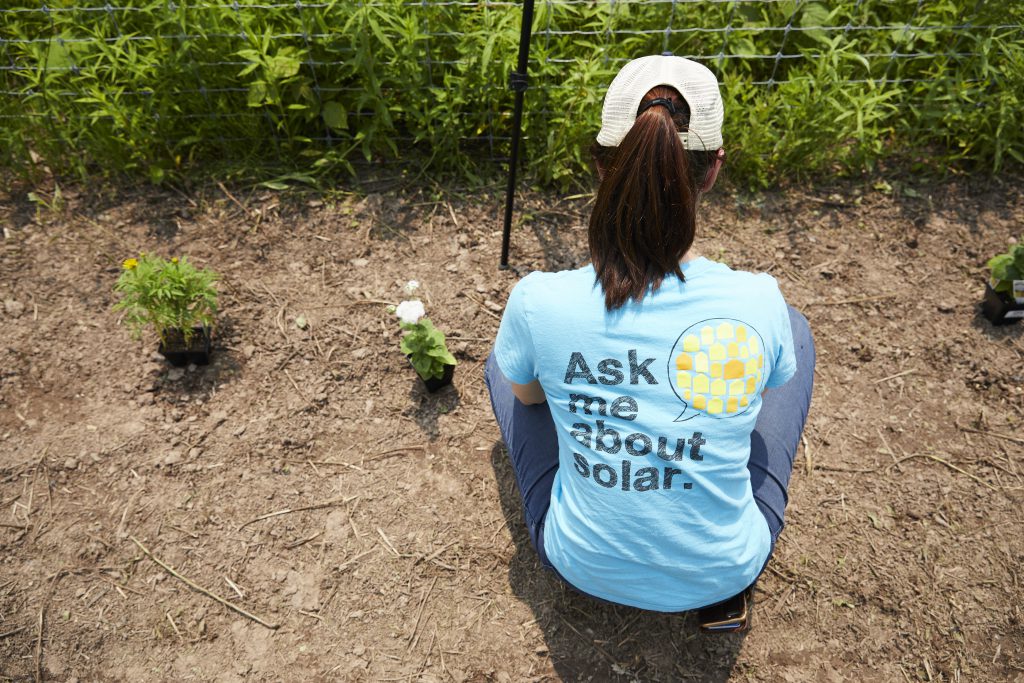

Show Pollinators Some Love:
Supporting pollinators doesn’t have to stop with planting wildflowers either! Here are a few more ways you can show our pollinators some love, recommended by the USDA:
- Stop or limit the use of pesticides on your property – pesticides are toxic to pollinators.
- Leave dead logs around your property so that bees can nest in them.
- Put out a hummingbird feeder!
- Plant milkweed plants – Monarch butterflies lay their eggs on the leaves and feed on the nectar of the flowers.
- Pollinators need water too. Use a shallow dish or bowl with half-submerged stones for perches.
- Build a bat house to give our nighttime pollinators a place to sleep during the day. Bats are not only good for pollination, but they eat mosquitoes too!
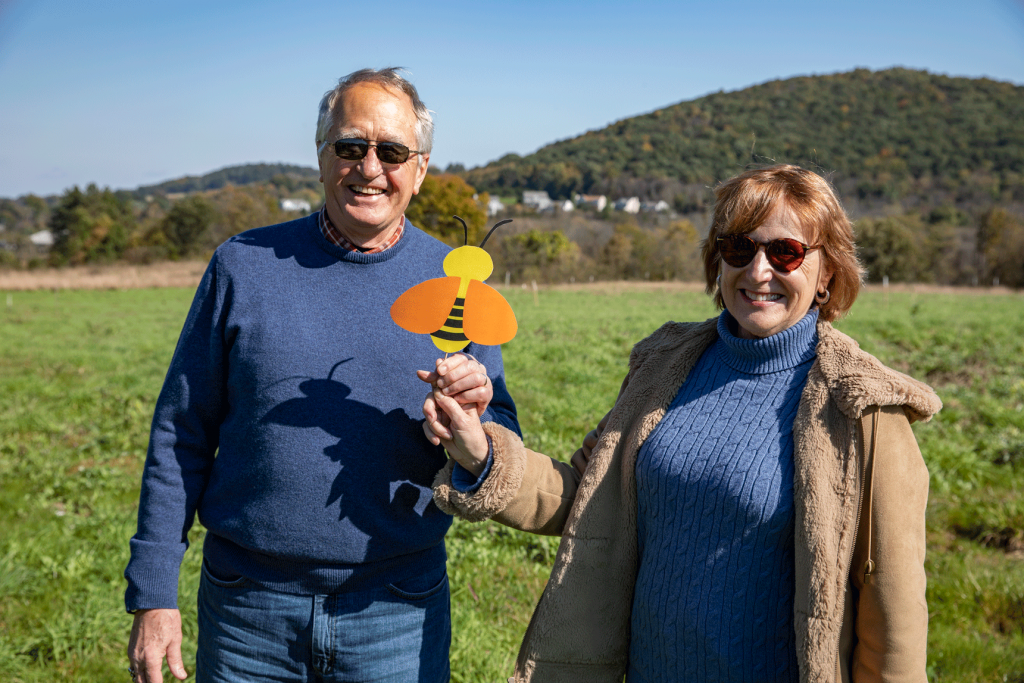

Did You Know?
- More than 150 food crops in the U.S. depend on pollinators, including almost all fruit and grain crops.
- Worldwide there are more than 100,000 different animal species that pollinate plants.
- One out of every three mouthfuls of food in the American diet is, in some way, a product of honeybee pollination.
Want to do your part to help pollinators? Consider joining a Community Solar Array.
Or, if you’d rather have solar at your home, plant some native species near your array!
Cocktail Recipes for Sunny Sips
What’s the best way to make a cocktail? With solar power, of course! Across Vermont and the Hudson Valley, SunCommon has solarized a heaping handful of distilleries, breweries, and vineyards. When businesses make the switch to solar power, it saves them money AND makes our grid greener… So, let’s cheers to a brighter future!
Since it’s almost summertime, we were wondering what kind of sunny sips you could make using (mostly) solar-powered beverages. We compiled a few of our favorites — We hope you love them as much as we do! And if you’ve got suggestions, please let us know… We’re always looking for a little Gin-spiration!
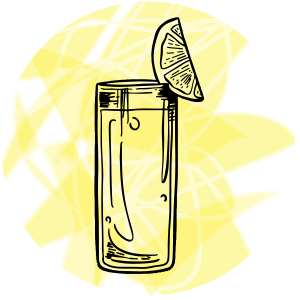

Gin & Tonic
There’s absolutely nothing wrong with a classic cocktail, especially when it features one of our favorite spirits: Barr Hill Gin! Here’s what you’ll need:
- 2 ounces Barr Hill Gin
- Your favorite Craft Tonic
- 1 Lemon or Lime Wedge
Better yet, this is easy to make! In a tall glass filled with ice, add your gin then fill ‘er up with tonic. Then, add your garnish!
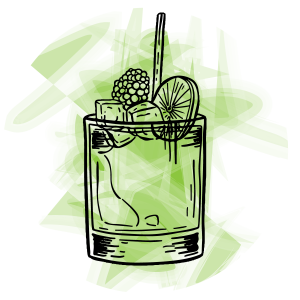

Gin & Hard Seltzer
Jumping off the classic G&T, we’re mixing it up with a beverage we just learned about from our friends at Rock Art Brewery. They’ve been running on solar since 2017 and are renowned for their craft beers. However, they recently released a spiked seltzer, and we think that’s worth a special shout out:
- 6 slices English Cucumber (plus a little extra for garnish)
- 1 Lime, halved
- 2 ounces Gin
- Rock Art Lime Spiked Seltzer
In a large glass, muddle cucumber slices and juice from 1/2 lime until cucumber is lightly crushed. Add gin and stir until combined. Fill two double old fashioned glasses with ice. Divide gin mixture between glasses. Top each glass with hard seltzer and garnish with additional cucumber slices, if desired. Cut your remaining lime half into two wedges; garnish drinks with lime wedges and serve immediately.


Ruby Red & Rosemary Cocktail
Next up? Let’s sip on some of Stoutridge Vineyard’s famous Six² Vodka! Subtly sweet cocktail recipes like this will be the talk of your next summer gathering:
- 1/4 cup Honey
- 1/4 cup Water
- 2 ounces fresh Ruby Red Grapefruit juice
- 1.5 ounces Six² Vodka
- 1/2 Lemon, juiced
- 2 sprigs of Rosemary
- 1 dash of Sea Salt (trust us on this one!)
First, make a honey simple syrup: Pour your honey and water into a small saucepan and warm over medium heat. Then, use a whisk to blend the honey into the water and remove from heat. [There is no need to bring the mixture to a simmer, and this process should only take a couple of minutes.] Next, fill a small cocktail shaker with ice. Pour in your fresh grapefruit juice, vodka, lemon juice and honey simple syrup. Top with a sprig of rosemary and a dash of sea salt. Put on the lid and shake until the mixture is thoroughly chilled, about 20 seconds. Strain into a martini glass and garnish with a small sprig of rosemary. Serve immediately.
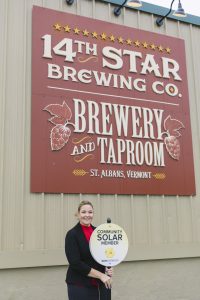

Last, but certainly not least…
For our final drink, we thought we’d throw something out there for our hard working hammock-hangers who just finished mowing the lawn. If you’re not feeling the cocktail recipes, don’t have the energy for shakers and simple syrup, or just ran out of ice… Crack open a solar-powered beer! Our friends at 14th Star Brewery chose Community Solar to power their business, and The Alchemist decided to go with our Solar Canopy!
So, why are all of these folks going out of their way to make solarized spirits? It’s because where you shop matters, and voting with your dollar really does add up: By supporting local businesses that support clean energy, you’re sending a clear message about what a brighter future looks like to YOU! Plus, if you do go solar with us, all of your cocktails will be sips of sunshine… Cheers, everyone!
Last year’s UN Climate Report has brought the existential threat of climate change front and center, so we wanted to share some dinner-table tactics that may help you feel prepared.
If you are inclined to dive into the thicket of disinformation, which may include “warming is a natural process” and mutterings about “the climate hoax,” here’s what you need to know:
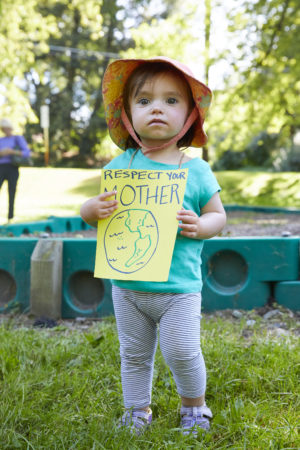

First: no one is more qualified to have this conversation than you.
As a friend or family member, you are what communication experts call a “trusted messenger.” People are more likely to believe those they trust and already have a personal relationship with. Other trusted messengers depend on the audience of course, but mostly they are standard authority figures; teachers, scientists, primary-care physicians and other health-care professionals, faith leaders, TV meteorologists, and staff at zoos, aquariums, museums, or nature centers are some examples.
You should feel empowered to cite these authority figures in defense of the facts. You’ve got the consensus of 97% of climate scientists on your side. But what if that isn’t enough?
Remember that oil giant ExxonMobil discovered the noxious effects of burning fossil fuels more than 40 years ago in 1977. Thirty years later, in Massachusetts vs. EPA (2007), the Supreme Court ruled that the EPA must classify CO2 as a pollutant, given that “greenhouse gas emissions present a risk of harm to Massachusetts that is both ‘actual’ and ‘imminent.’” The government’s own research had already determined that “global warming threatens… a precipitate rise in sea levels, severe and irreversible changes to natural ecosystems, a significant reduction in winter snowpack with direct and important economic consequences, and increases in the spread of disease and the ferocity of weather events.”
Arrive prepared with strong narratives.
Psychology tells us that our minds are hardwired for storytelling, not logic and number processing. Charts and climate data are helpful to deepen one’s understanding of the effects of global warming, but not necessarily for those who are skeptical of the premise to begin with. To communicate complex topics such as how greenhouse gases work or how global warming brings about more intense weather conditions, the UN recommends leaning on analogies.
Examples of useful climate analogies:
1. The Heat Trapping Blanket
Think of greenhouse gases as a heat trapping blanket. Carbon dioxide, methane, and (to get real nerdy) chlorofluorocarbons are heat trapping gases. They’ve always existed in the atmosphere, but since the industrial revolution, we’ve drastically changed the proportions. The more of these gases we put into the atmosphere, the thicker the heat trapping blanket gets, raising the temperature of the planet.
This was first proven by ExxonMobil in 1977 and subsequently buried in their archives for decades while they pretended ignorance.
2. Loading the Weather Dice
Increased emissions are “loading the dice” for extreme weather events. Sure, climate and weather are different, but weather is determined by climate. While we can’t say an extreme weather event is caused by climate change, we know that climate change is “loading the weather dice” so to speak, making certain extreme weather events more likely—such as flooding, hurricanes, and polar vortexes.
3. The Boiling Pot
A link between global warming and extreme weather events is the warming ocean surface temperature. One reason climate change has been a slow and gradual process is that the ocean actually absorbs a huge amount of heat and carbon dioxide. In the last 100 years, the ocean’s surface temperature has risen more than 0.5º C. In the same way that boiling water releases steam, a warmer ocean evaporates more quickly. More evaporated water is essentially fuel for tropical storms, intensifying them. Models project a 45-87 percent increase in the frequency of Category 4 and 5 hurricanes.


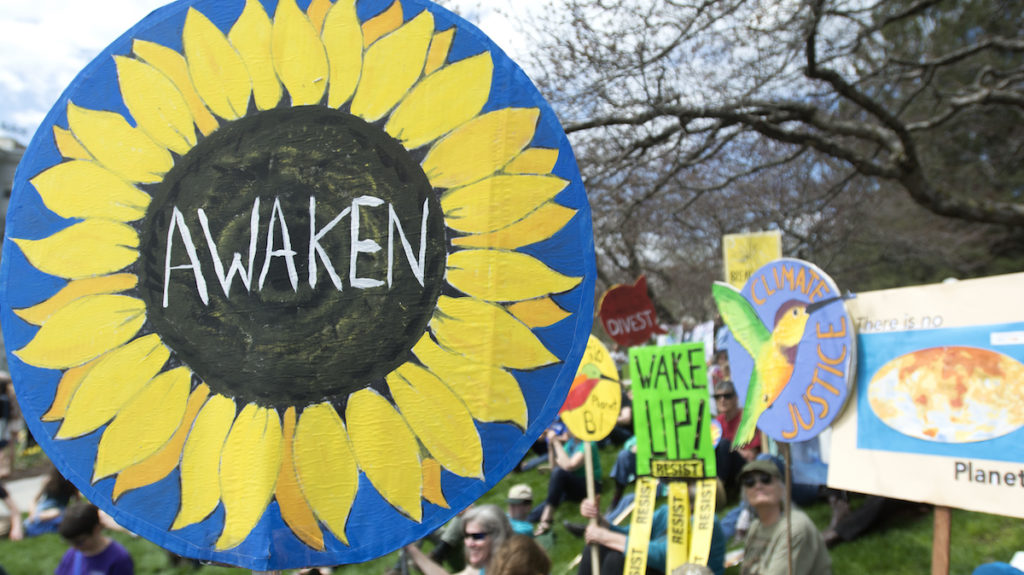

Ground the conversation in local experience.
Bring the issue close to home. Climate change is ubiquitous — its effects can be felt in every region. If you’re traveling, try bringing up a climate issue local to where you’re staying. If you’re with family in Boston for example, bring up the threat and consequences of rising sea levels on Cape Cod. Folks in the Midwest may respond better to reminders of the record-breaking flooding and devastating hurricanes like Sandy and Harvey. And, of course, if you’re out west, the fires are hard not to think about.
Forget about “climate change” and work together towards solutions.
Maybe they won’t buy your compassionately delivered climate change explanation, that doesn’t mean you can’t convince them to join you in embracing climate solutions! It turns out that even “climate truthers” can get on board with saving money on their electricity bills. Whatever your views are, supporting renewable energy just makes sense:
- Solar installation costs have dropped 70% since 2010 in the United States
- Solar is likely to become the world’s cheapest energy source in the next decade. In the southeast, solar and wind are beating new gas plants in efficient energy production. “By 2025, almost every existing coal plant in the United States will cost more to operate than building replacement wind and solar within 35 miles of each plant.”
- The renewable energy sector is good for the economy, creating jobs faster than almost any other sector. The U.S. Bureau of Labor Statistics forecasts that America’s two fastest-growing jobs through 2026 will be solar installer (105% growth) and wind technician (96% growth).
Beekeeping may seem like a real challenge if you have no idea where to start. We spoke with local beekeeper, Gwynne Berry, and got the scoop on what it takes to make your own honey. Read on to learn more about the supplies you’ll need to get started, and discover how important bees are to everything around us!
How did you become interested in beekeeping?
I have been beekeeping for about 6 years now. I was drawn in by the idea of harvesting your own honey, but very quickly became fascinated with the bees themselves. They have a matriarchal social structure with the queen living for 2-3 years and the males (drones) living for 6-8 weeks. The video below shows a baby bee coming out of its cell.
I love how for each stage of life, the bee has a specific job. It’s amazing how much a single female worker bee accomplishes in her 45 day lifetime. Days 1-11: Nurse Bees take care of the brood and clean the cells. Days 12-17: Funeral Bees remove the dead, make wax, and carry food. Days 18-21: Guard Bees protect the hive, check every bee that enters, and takes care of any intruders. Days 22-45 (and beyond): Field Bees go from flower to flower collecting pollen.
What kind of advice would you give beginners and those thinking about beekeeping?
Research! Read books and watch videos. Join or follow a local beekeeping group. These will give you the step-by-step guides on how to set up and take care of your hive, as well as tell you what NOT to do – which is extremely helpful! I also took a small “Intro to Beekeeping” class. The running joke is that there are as many ways and styles of beekeeping as there are beekeepers!
What does it take to get started with beekeeping?
Most beekeeping catalogues will have a starter set to choose from (try Betterbee out of the Adirondacks). I think if you are able, start with two hives — it is better than one. It allows for diversity, and if one hive gets into trouble, you can supplement brood from the other hive. I always try to get bees that are adapted to the Vermont seasons. Finally, I prefer starting with a nuc (five full frames of drawn comb and brood) versus a package of bees (no comb or brood). Our season is short and it is best to start with the strongest bees you can.
How much time does beekeeping take, and is it seasonal?
Starting around April through November, you can expect to go into the hive every three weeks or so. Most of the time it will only take 5 to 10 minutes – just a quick peak to see how full the frames are and determine if a new box needs to go on. Other times you will need to do a full inspection. A full inspection needs to be done on a warm sunny day and will take some time – especially for new beekeepers. Because of this, it is best to watch a video first so you’ll know what to expect.
When I first started out, I went into the hive all the time. I was fascinated (and still am) by how the bees lived, worked and communicated with each other. However, this will stress your bees out. It is actually possible to love your bees to death – I once had a hive abscond because I went in too often and they felt unsafe.
Once winter arrives, you will just check to make sure that no snow is covering their entrances and perhaps occasionally scrape out the dead from the bottom. Overall, it is very low maintenance.




What tools are required for beekeeping?
Above all, a good bee suit will be one of your most important investments. I like the full suit because it allows me to feel relaxed and not worried that a bee has snuck its way in! In the spring, the bees are very docile — They are focused on growing and feeding the hive. I often will come and sit right next to a hive in nothing but shirt and pants! I love to listen to the different sounds of the hive and watch the foragers come and go. It is fascinating to see all the different colors of pollen! However, in the fall, the bees will become more aggressive. They are territorial and protective of their winter food supply and do not want to anyone near the hive. Therefore, the full bee suit is best!
Depending on where you live, you will also want to put up an electric fence. Bears love to snack on the brood (larvae). We had a bear find our hives a few years ago and it was devastating to watch the bear toss and tear them apart. It was a total loss for the bees. The next year we put in a very sturdy electric fence.
Additionally, some other items you’ll need include a hive tool, a brush, and a smoker.
What have you made with your honey and beeswax?
This past year we made beeswax wraps for food. It was so fun and easy, and made for some great gifts! We have also made candles and hand cream — The internet is full of ways to do this! We use the honey in many of our baking and dinner recipes, and we also use it to help with allergies. The next thing we are going try is making kombucha using our honey!




Why are pollinators so important? Do bees help with other aspects of your homesteading(ish) lifestyle?
Bees will travel up to a five mile radius from their hive, and a single bee can pollinate 5,000 flowers in a single day! Our gardens and fruit trees are so much healthier with the bees. Our blueberry bushes have become much more prolific due to help from the ladies. I love seeing the bees go from tomato flower to tomato flower and know that we are helping each other!
What inspires you the most about this process and how does it contribute to your idea of a brighter future?
I love hearing from neighbors that they have seen honeybees on their plants. When we give them honey it’s cool to know that their gardens provided to the honey bees’ stores. My daughter and I have gone to a couple elementary schools to teach kids where honey comes from. It fascinates me to see the interconnection between these insects and the food we eat. It has brought an awareness to our environment on a micro level that we (our family and friends) did not have before.
My hope is that as more people become aware of how important these pollinators are — bees and butterflies — and that they will become more conscious of what they put in the ground. This will certainly help bring about a healthier relationship with the world we all live in.
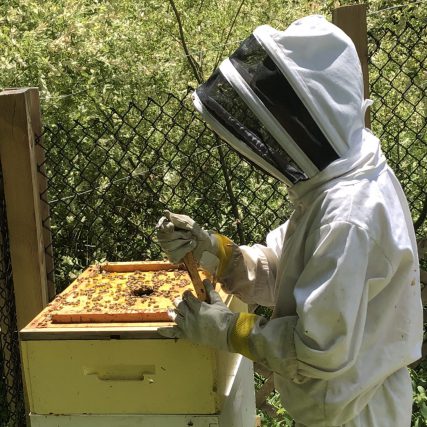

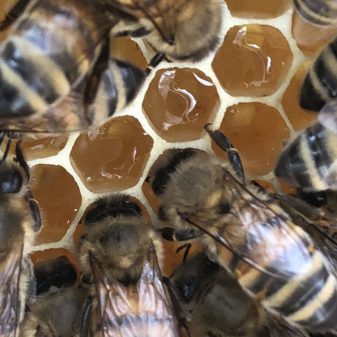



Did this blog have you BUZZING?!
If you enjoyed this blog and are interested in more home and garden content, you should check out our How to Start a Garden Blog or learn how you can Make Every Day Earth Day!
How do I go solar?
The process for going solar is simple. It starts with filling out our get started form. You can do so by clicking the get started button. If you want to know more details about the process and the steps involved between signing up and turning on the power, click the button below to find out more.
Earth Day at Home
Although it looks a little different this year, celebrating Earth Day at home is easier than ever. A whole bunch of small actions is what we need to continue building more vibrant communities and a brighter future for all. That being said, we’ve compiled a list of 8 wonderful actions you can take to make a difference for your beautiful corner of the world… no matter where you call “home”!


1. Plant a Tree
Trees help clean the air we breathe by absorbing harmful pollutants and releasing clean oxygen. Their intricate root system filters the water we drink by removing pollutants. Trees also capture rainwater and reduce the risk of natural disasters like floods and landslides. Trees help cool the planet by sucking in and storing harmful greenhouse gases, like carbon dioxide, and can reduce the overall temperature of the earth. And last, but certainly not least, a single tree can be home to hundreds of species of insect, fungi, moss, mammals, and plants. We can’t imagine you’d need any more reasons to plant a tree, but if you do, you should check out One Tree Planted, because they’re kinda good at this stuff: They planted over 4 MILLION trees in 2019! (The most we’ve managed so far is 1,200 in a day… Not a bad start!)


2. Clean Up Your Neighborhood or Park
If you’re looking to get some fresh air while making an impact on your community and local wildlife, why not clean up your neighborhood or a local park? Although many hands make light work, it’s a safer bet right now to clean up areas around you while maintaining a safe distance from others. One tip to help you out while you’re cleaning up your community is to have one bag for recyclable materials and one bag for waste materials. If you’re looking for a park nearby, take a look at this map. Also, check out this awesome video, “Power of Parks”:
“Parks have the power to impact every community through health and wellness, conservation and social equity.”


3. Build a Birdhouse
Building a birdhouse is an activity the whole family can get involved with! You can get really creative here and add some serious flare or keep it natural so it blends in with its surroundings. Whichever route you choose, the birds will be “singing” your praises! There are pre-cut kits available, or upcycled versions can be created from supplies you have around your house. Or if you’re really handy, you can build one from scratch with this 7-step tutorial!
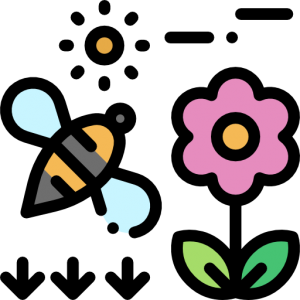

4. Plant a Pollinator-Friendly Garden
Did you know that bees contribute over $20 billion to U.S. crop production? Bees play a role in nearly all food production – even meat and dairy! Our cattle need barley and alfalfa to eat, which the bees pollinate. Without bees and our other pollinator friends, human diets would be very different. We love having the ability to plant wildflowers at our Community Solar Arrays. If you’d like to attract pollinators to your garden using native plants, you should check out this guide from the U.S. Forest Service, or check out some quick tips here. You can even type in your zip code to see which wildflower species are native to your location!
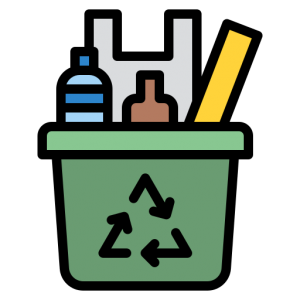

5. Keep Recycling
It’s hard to believe, but the average person throws out about five pounds of trash daily. And what’s worse? 75% of garbage is actually recyclable (or compostable — more on that later!), but we only recycle about 30% of it here in the United States. If you’re here on Earth Day reading this, we’d bet you’re probably already doing your bit with recycling… But, if you need a refresher or you’re just starting out (you’re welcome, kiddos!), here’s a list of the most commonly recyclable materials and how to recycle them. We’re also adding a fan-favorite resource here, which has an even bigger list of recycling-focused information — crafts and coloring books included!


6. Start Composting
Composting is an action all of us can take at home to reduce our carbon footprint. By diverting food waste from our trash cans, we can avoid filling up landfills with products that leak potent greenhouse gases, like methane, when they decompose. We’re happy to share this guide to composting at home, but if you want the “quick and dirty” (pun intended) process, check out our video below!


7. Finish an Upcycling Project
Have you been storing some old furniture in your garage or attic that’s been collecting dust for the last 10 years? Yeah, us too. If you’ve been itching to bring an outdated piece back to life, now is the perfect time to get it cleaned up and in tip-top shape to help beautify your living space — or, you can sell it for some extra cash! Upcycling is important because it reduces the amount of waste that goes into landfills while minimizing the amount of energy it takes to produce new items. Hopefully these amazing projects will provide you with some serious inspiration!
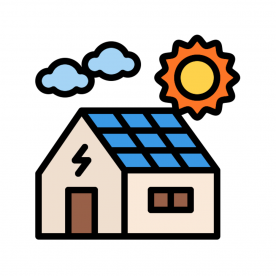

8. Check Out Solar With a Virtual Visit
Of course, we might be partial to this idea for Earth Day at home, but we’d love it if you joined our community of solar superstars! We’re offering virtual home visits for the foreseeable future, and even have Community Solar options that you can sign up for entirely online. Oh, and be sure to check out our SunCommon at Home page to learn more about maximizing your clean energy potential.
Starting seeds indoors is inexpensive, fun, & so rewarding. There’s the anticipation of waking up every morning hoping you’ll see the first sprouts coming up in their tiny trays, followed by feelings of pride knowing you’ve kept your plants growing strong with a little TLC! We promise you don’t have to have a green thumb to enjoy your very own garden — Follow these simple instructions and you’ll be growing your own crops in no time!
So, what is Transplanting?
When you plant a pre-grown plant into the soil after last frost, it’s considered a transplant. The plants you buy from the nursery and the ones you start in trays are considered transplants. It’s best to transplant plants that have a longer growing season, to get a good head start on their development. If you plant correctly, transplants can be stronger and more resistant to weeds or pests than direct-seeded plants. You can also create a succession planting schedule with transplants, ensuring you’ll have a good crop all season long.
Good for Transplanting:
Tomatoes, Peppers, Eggplant, Celery, Collards, Kale, Broccoli, Kohlrabi, Leeks, Onions, Scallions, and more!
It’s Time to Get Started!
Do you have your supplies? (Here’s what you’ll need!) Ready to play with some high-quality dirt? Good! Let’s begin…


Step 1.
Fill your cell packs with soil. Don’t pack it in, just fill them up. You can sweep it across the surface of the containers to fill it evenly. The soil should be a little bit loose — roots need space to grow!
Step 2.
Water the soil so it’s thoroughly soaked. The volume will probably shrink to about half its size. Add a little more soil if necessary, so that each container is no more than ¾ full. Water again.




Step 3.
Choose your seeds! If you’re using grow lights, be sure to select similar seeds for each tray, as it’s difficult to manage different plant heights.
Step 4.
Look at the seed packet to see what the soil depth requirements are. Note that smaller seeds such as cherry tomatoes generally require a much shallower soil depth (⅛-¼” deep) than much larger squash seeds (1” deep).




Step 5.
Grab your dibber — A dibber is a pointed wooden stick used to make holes in the ground so that seeds, seedlings, or small bulbs can be planted. Pro Tip: No need to get fancy… A pencil or chopstick works great here!
Step 6.
Use your dibber to create holes in your container the depth your plant requires. If you plan to seed 10 plants, make 10 holes. It’s easier to keep track of your progress if you work plant-by-plant.




Step 7.
Double the quantity of plants you intend to seed. Carefully pour that quantity of seeds into a shallow bowl. (Watch out if you’re working outside on a windy day!) Then, put 2-3 seeds per hole. It’s easier to have extra plants in one hole than to waste the real estate.
Step 8.
Cover up the seeds with the appropriate thickness of soil.




Step 9.
Label your plants. Popsicle stick labels work great for starting seeds indoors in trays, but when you move the plants outside, you can have some more fun with plant markers… Check out some of these cool upcycled plant marker ideas!
Congratulations — It’s Party Thyme! (Get it?!)
If you’ve followed these simple steps to get your garden started, you should be seeing your first sprouts in as little as 7-14 days! And, if you’re ready to up your garden game, we’ve got a few more tricks of the trade to share…


- Water regularly with a gentle source, ensuring the soil is moist, but not soaking wet. Ensure your tray has good drainage—water should flow through it. And, if you have a heat mat, use it! You can put your tray right on top. At this point, sun isn’t actually as important as warmth & even moisture.
- If you use a windowsill: As soon as plants have sprouted, place your trays in a very sunny location, where they’ll receive a minimum of 6 hours of direct sunlight a day. Rotate trays at least twice a day to ensure your seedlings get maximum even sunlight coverage.
- If you use a grow light: As soon as plants have sprouted, suspend your grow lights directly above the seedlings, but not touching the plants. Raise your light as plants grow.
- Keep your plants inside until well after last frost, as they’ll be extra sensitive to cold temperatures.
- Harden off your transplants before planting them outside, or they’ll suffer shock. Gradually expose transplants to the outdoors, for increasingly lengthy periods of time. Start with one hour on a nice day, then two hours, & so on, until they’ve acclimated to overnight temperatures.
Phew. That was a lot!
If you enjoyed this how-to guide and are interested in more home and garden content, you should check out our Composting Blog or learn about Five Easy Climate Actions you can take at home!
How do I go solar?
The process for going solar is simple. It starts with filling out our get started form. You can do so by clicking the get started button. If you want to know more details about the process and the steps involved between signing up and turning on the power, click the button below to find out more.
There are lots of reasons to start your plants early from seed — it’s a quick, easy, low-cost, sustainable way to ensure that your refrigerator is always filled with your favorite vegetables and herbs. You can also start lots of flowering plants from seed, including the blooms that look lovely in a bouquet on your dinner table. Read on to learn how to start a garden of your very own!
It’s Easy to Start from Seeds
Because it’s so inexpensive and easy to start plants from seed, it’s a great opportunity to try new varieties—if a crop doesn’t work out, there is less pressure from wasted time or money. A seed packet costs about $2.00, and often includes over a hundred seeds (each a potential plant!), while a single pre-grown plant often costs at least $4 each.
There’s a huge variety of seeds available in the United States and abroad. Companies such as Hudson Valley Seed Company, FEDCO Seeds, American Meadows, Seed Savers Exchange, and more offer healthy, non-genetically modified seeds that are just not available as transplants. Additionally, by buying heirloom seeds, you’re supporting history— many of these varieties have been recorded in the United States and abroad since the 18th century or earlier. Have you ever wanted to try a Singara Rat’s Tail Radish? Or a Scarlet Runner Bean? Turmeric? Now is your chance!
One word of caution: When trying a new plant from seed, be sure to check with your state’s Department of Environmental Conservation that it’s not an invasive species in your area before planting—for example, while it’s illegal to buy a Phyllostachys aurea (aka golden bamboo) plant in New York, it is still possible to get seeds. Most companies ship around the world, and not every type of seed is appropriate for your location. If you’ve ever battled with Artemisia vulgaris (common mugwort), you’ll appreciate the importance of preventing the spread of invasive species in your garden.


Not All Growing Methods are Created Equal
Most growers utilize both transplanting and direct seeding when starting their plants from seed. It’s recommended to use both methods, depending on the plant. Check out the lists below to see the plants that typically work best with each method.
Transplanting: When you plant a pre-grown plant into the soil after last frost, it’s considered a transplant. The plants you buy from the nursery and the ones you start in trays are considered transplants. It’s best to transplant plants that have a longer growing season, to get a good head start on their development. If you plant correctly, transplants can be stronger and more resistant to weeds or pests than direct-seeded plants. You can also create a succession planting schedule with transplants, ensuring you’ll have a good crop all season long.
Direct Seeding: Some plants are best started directly from seed, in the soil. Usually, growers choose this method either because these plants, once established, have delicate root systems and dislike transplanting, or because they’re quick to germinate and have a shorter growing season, thereby eliminating the need to jump-start the season ahead of time.
Transplanting
Tomatoes
Peppers (sweet, Bell, or spicy)
Eggplant
Celery
Collards
Kale
Broccoli
Kohlrabi
Leeks
Onions
Scallions
Direct Seeding
Spinach
Peas
Beans
Radish
Beets
Carrots
Turnips
Zucchini
Melons
Squash
Pumpkins
Get Ready to Seed
Plan Your Timing Well
In order to ensure that your crop is timed for its best harvest, be sure to research the average last frost date for your area. In the Hudson Valley and New England, it’s around April 26th. Some plants, such as watermelons, do best in warmer soil and need to be transplanted out well after last frost, while others, such as sweet peas, prefer to be direct seeded in cooler temperatures. Check the back of the seed package for each plant’s requirements.
You’ll also need the grow times—usually also listed on the back of the package—for each plant before seeding. This number reflects the days it will take for the plant to reach full maturity, bearing vegetables or flowers. You’ll notice that grow times can vary widely based upon each plant, so it’s important to plan accordingly. Mesclun mixes, for example, are usually 40-60 days to maturity, while watermelons are 70-90 days. If you want to harvest watermelons in July, for example, plan to seed them by April 5th at the latest.
Succession Planting
You can also create a succession planting schedule for the crops you use regularly all season long. With succession planting, you seed the plant every two weeks throughout the season to ensure a steady crop. Here are some foods that are commonly succession-planted:
- Herbs (cilantro, basil, dill)
- Lettuces
- Arugula
- Spinach
- Radishes
- Carrots
- Beets
- Pole beans
- Scallions
- Kale
So… What Else Do You Need?
Once you’ve calculated your seeding dates and know when you need to begin, it’s time to gather your equipment:


- Choose Your Container:For this tutorial, we reused cell packs from last year; however, we recommend trying soil blockers to start your seedlings; they are a new seeding method that is gaining popularity for its lack of waste, zero added cost, & ease of transplanting.
- Use a Good Seed-Starting Soil Mix: A good OMRI-listed seed-starting mix (not potting!) ensures that your plants will get off to a good start with a healthy root system & minimal fungal or chemical exposure, which could slow or impede growth.
- Water, Water, Water: Water your soil before you seed; water your plants when you seed; and water both lots afterward!
- Invest in Heat Mats: Heat mats will seriously speed up seed germination for your plants, while increasing overall germination rates. They really do work!
- Try Grow Lights: Grow lights will give your plants a boost when they need it most—as seedlings. Properly using grow lights will ensure stocky, healthy plants that will grow strong & produce great fruit for the season.
- Label Your Plants: After all your work preparing for your seeds, you need to keep track of which plant is which, so you can tend each one as it requires. Plant ID tags make it super easy, & most are reusable.
It’s Finally Time to Get Started!
Is it the correct time of year to start seeding your plants? Do you have all your equipment together? If the answer is yes, you can finally start seeding! Stay tuned in the coming weeks for more information on how to start your garden… In the meantime, you should check out our Composting Blog or learn about Five Easy Climate Actions you can take at home!
How do I go solar?
The process for going solar is simple. It starts with filling out our get started form. You can do so by clicking the get started button. If you want to know more details about the process and the steps involved between signing up and turning on the power, click the button below to find out more.
Did you know that only 15% of clothing is recycled or donated? That means 85% ends up in landfills. Besides all that waste, the clothing industry has a laundry list of damaging effects on the environment. The most noteworthy offenders: carbon emissions, water consumption and water pollution.
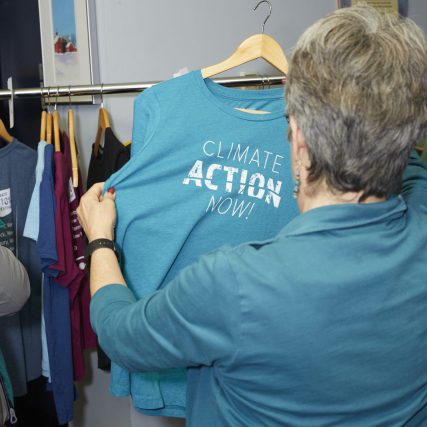

Clothing is made out of two materials: Synthetic (like polyester) or Natural Fiber (like cotton). However, each material comes with its own set of baggage.
Synthetics are made from crude oil, which releases two to three times more carbon emissions than cotton. The World Resources Institute has revealed that polyester production in 2015 accounted for 1.5 trillion pounds of CO2. That is equivalent to the annual emissions from 185 coal-fired power plants. Yikes. Plus, since polyester is essentially plastic, it takes hundreds to thousands of years to break down, and each time the garment is washed, hundreds of pieces of microplastic are released.
Cotton, on the other hand, is biodegradable… But that doesn’t outweigh its drawbacks. Cotton farming uses an enormous amount of water. The United Nations Environment Programme has calculated that it takes approximately 2,000 gallons of water to produce one pair of jeans. That’s enough water for one person to drink for 10 years! As a whole, the fashion industry is the second-largest water consumer AND second-largest water polluter on the planet. On top of the water consumption, the chemicals used in textile dyeing are rarely disposed of properly and often end up in streams and rivers.
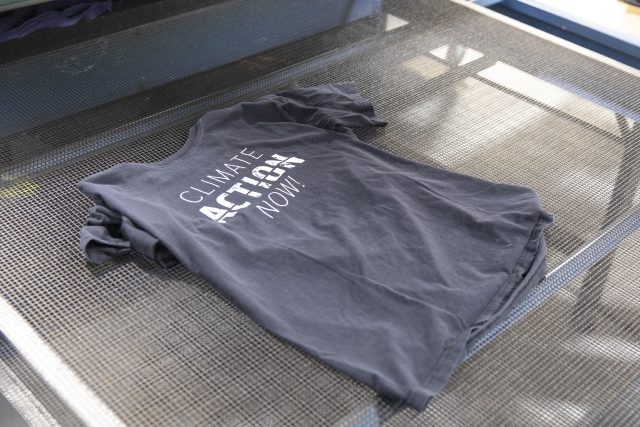

Did You Know?
It takes approximately 2,000 gallons of water to produce one pair of jeans… That’s enough water for one person to drink for 10 years! Recycling clothing can help reduce water waste.
Over the past 18 months the world has started to make some real progress for the planet: several municipalities have enacted laws to limit disposable plastic use, NYC now requires all new construction to include solar or a green roof, and plant-based foods like Beyond Meat are becoming mainstream. However, the clothing industry has yet to have its climate-saving moment.
That’s why we created our Climate Action Film Festival shirts using pre-worn garments from our friends at Helpsy in White Plains, NY. Helpsy is a fellow B Corp with an environmental mission, committed to keeping clothes out of the trash, and supporting their community. During their hard work in 2018, they produced a net negative carbon footprint and avoided the use of 3 billion gallons of water. They have offset 320 Million pounds of CO2—that’s equivalent to the annual output of 31 wind turbines! Helpsy is not only committed to the planet, but also to our communities and our people. This past winter they provided over 120,000 high-quality used winter jackets to those in need in the NYC area.
Check out our recycled shirts from Helpsy being printed at New Duds!
In short, reusing and recycling clothing is a big deal. It reduces the environmental burden of the second-most polluting industry in the world. So next time you need a new piece of clothing, check out your local thrift shop.


Did you enjoy reading about recycling clothing?
If so, you can find more content over on our Blog, or learn more about the Climate Action Film Festival!
How do I go solar?
The process for going solar is simple. It starts with filling out our get started form. You can do so by clicking the get started button. If you want to know more details about the process and the steps involved between signing up and turning on the power, click the button below to find out more.
There have gotta be upsides to staying home more often, and we’re here to share a few. Whether you’re reading this in the COVID era or well beyond, we’ve compiled a list of healthy home life habits that have helped us feel better about increased isolation. For the record, I’m speaking from experience here, but there are many things on my household to-do list that I’ve left off the record. I wouldn’t dare preach to you about all the raking I’ve avoided, or the eight books on my bedside table that each have a bookmark on chapter two. Check out the healthy habits I’ve picked up lately and share some of your personal favorites with us!
Bake your own bread!
Maybe you’re tired of hearing this, but it bears repeating. We’re certainly living in a show-off-your-bread-on-social-media moment, but don’t let the overwhelming trendiness prevent you from missing out on the benefits of baking. A friend of mine recently recommended a book called “Make the Bread, Buy the Butter” by Jennifer Reese. The basic idea is that many DIY projects are worth the time and effort, and many are not! Bread falls into the “cost savings” category, but I’d hardly consider that the most notable benefit.
The fact is: homemade bread tastes better than anything in the store, and it’s not hard to master. With zero prior experience, I started out with a Simply Crusty White Bread recipe, and evolved to the Pain de mie – both of which turned out to be way easier than I expected. I recently made an amazing batch of French bread, then graduated to Japanese Milk Bread, which I dare say is my favorite bread of all time. Pretty soon I’ll start experimenting with sour dough soon, expect a blog post all about that!




Invent a new soup
You’ve got the bread, now for the main course! Ditch the can, making soup from scratch is easy and delicious. This may seem intimidating to some, but with the right starter ingredients, I believe everyone is a soup chef in hiding. Last week I had a head of purple cabbage, smoked bacon, carrots, celery, onion, garlic, and bone broth, this ended up being a tasty and improvised stew! I didn’t have a recipe to start with, but the basics of cabbage soup are easy to riff off of. I suggest starting with a recipe and let your pantry fill in the details!
Shop local
There has been a huge surge in grocery shopping lately, as folks plan to stay home for a longer stretch. While I suggest supporting your local co-op year round, this era is especially important. Local farmers and vendors have been hit hard by the closing restaurants and canceled events, independent retail is one of the few remaining outlets to support them. Whether you’re reading this in April of 2020 or much later, the fact remains: our local food shops need our support to thrive and continue serving our community.
Shopping local matters, and so does voting with your dollar. Check out our recent post about buying B Corp.




Check on your gutters!
This one may be obvious, but you’d be amazed by the jungle that may be growing in your gutters! This should be a twice-a-year ritual for homeowners, and spring is the perfect time to get gloved-up and make room for rainwater! I found this Bob Vila instruction useful.
Stretch After Exercise
One of the most overlooked aspects of exercise: the post-workout stretch! All the Yoga folks out there know exactly what I mean, but for a casual basketball player (emphasis on casual) like myself, this can easily be forgotten. Check out these 6 simple stretches if you need a tip!




Schedule some social time
It’s never been more important to stay connected with friends and family, this cannot be overstated. I’ve found that setting your intention to socialize in advance can be helpful as heck, especially if you’re prone to losing track of time, or getting lost in your introverted activities around the house.
This Friday, a few of my friends are getting together on an app called houseparty, but you can also use Apple’s FaceTime, Google Hangouts, even Instagram has a group video chat option. There are also collaborative gaming platforms like Kahoot, if you want to get really creative! If you’re working from home, it can make a huge difference to have a little joy on the calendar to look forward to.
Examine your personal data organization
Whoa, now here’s something you might not have thought about: how messy is your personal file archive? Family photos, downloads, music library, old projects, the gigabytes can really stack up! As a professional photographer, I have a handful of terabytes to manage, but I believe this is crucial work for everyone. For me, many RAW files become unnecessary to hold onto over time, many duplicate files can occur, it’s important to examine these occurrences when you have downtime.
Even more important, take a look at your data backup situation and see if it could use improvement! If a file is important to you, it should live in at least two places, ideally more. Photos are the big thing that come to mind for many folks. Do you have a complete backup of your photo library? Are you syncing your photos with a cloud backup of some kind? This may be the least exciting bullet point on my list, but it could make a huge difference if your phone or computer gets lost.


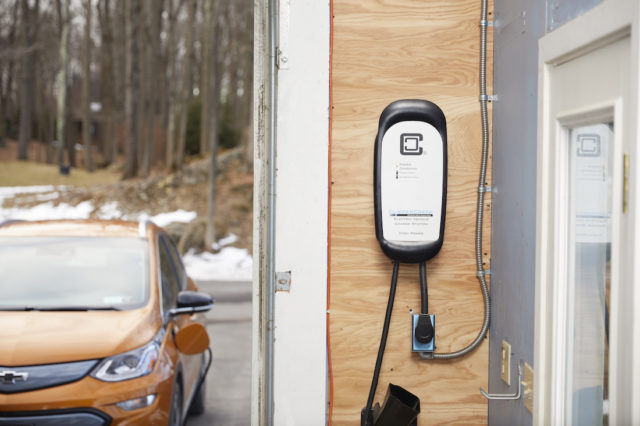

Keep a clear garage
If you don’t have a garage, skip this one, and I recognize it is somewhat of a limited perspective I’m offering here. If you do, and you’re unable to park a vehicle in the garage due to storage or clutter, I’ve got an important message for you: Parking in a garage is one of the most subtle but incredible lifestyle upgrades I’ve discovered. For those indoor parkers out there, you know what I mean. If (and this is a big if) there’s a chance of rearranging your garage storage to accommodate your vehicle, I highly suggest prioritizing this project!
Garage space becomes even more important as we transition to driving electric vehicles. In case you missed it, check out our top five unexpected bonuses of driving an EV.
Smarter food storage
How neat is your pantry? How about your fridge? I asked myself this question a couple of weeks ago and it resulted in a complete gutting of my cabinets and fridge. If you ask my wife, I never put things back in the same place, and that’s obviously a recipe for disorganization. One trick to solving this of course is having designated spaces for each food item, and I’ve found that works nicely in the dry food storage cabinets. If you’re thinking about reorganizing your food storage, don’t put it off – the results are SO satisfying!
In addition to where food is stored, it’s also important to think about how food is stored. See our recent “Alternatives to Single-Use Plastics” for more inspiration.




Make your own granola
Ok, ok, I have already suggested you make soup AND bread, but what about the early hours of the day? Trust me, there is nothing easier and more rewarding than a fresh batch of homemade granola! I’ll make it simple and link you to my all time favorite recipe, but lemme just tease it by saying cornflakes are involved and you will NOT regret this.
Little changes to your daily routine really add up. If you’ve found any of these tips useful, or have some you’d like to share with our community, tag us on social media!



